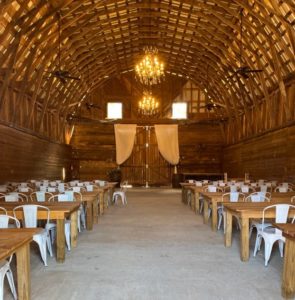

About our farm
Hodges Family Farm is recognized as a well-preserved, early 20th-century farmstead associated with a prominent local family and an important contributor to Mecklenburg County’s agriculture industry. Built by Eugene Wilson “E.W.” Hodges in the early 1900s, the farmhouse was the centerpiece of the Hodges family’s large parcel of land. The farm flourished with E.W. at the helm, producing multiple subsistence crops including corn, barley, oats, and cotton. Upon his passing in 1943, E.W.’s two sons—E.W. Hodges, Jr. and James Franklin Hodges—inherited the farm. In 1969, James transitioned the 187-acre farm into a well-known dairy operation that continued to operate until 1999.
In 1999, James Franklin (“Frankie”) Hodges, Jr. took over operations of the farm and was the first Farm Manager to open the doors of the Farm to the public. Frankie grew the Farm’s operations to include agritourism, education, therapy horses, and events (including the annual Pumpkin Patch). When Frankie passed away in 2015, the reins were given to Connor Newman (son of Joyce Hodges Newman) who has added multiple annual events and expanded the farm’s offerings to include an online Farm Shop that sells fruits and vegetables grown on-site using regenerative agriculture practices, plus local honey, and pasture-raised poultry, pork and beef.
The Hodges Family continues to be involved with the farm’s operations and offerings and they look forward to preserving the farm’s historical significance and sharing it with the community for years to come.

The regenerative path...
Just like most natural processes, there was no single event that started us down the regenerative path on our farm, but rather it was cascading and compounding events that led to the adoption of regenerative principles.
When asked if we would consider organic production—with the sage wisdom collected over my three years of experience at the time—I gave the standard response in economics terms: “It will take 3-5 years of reduced yields before the fields "adjust" plus the Organic(tm) stamp was too expensive.

This did, however, lead to my reading more articles about conservation agriculture and reduced tillage. I have always been insecure about being underinformed, so I devoured everything I could find in the NRCS database and beyond, subscribed to no-till podcasts, and eventually came across a copy of “Growing a Revolution” by Dr. David Montgomery. This was the first time I encountered “regenerative agriculture,” the folks involved in what was, in reality, a socio-agricultural movement, and the first system I had read about that made ecological sense (my background is actually in environmental science, not agriculture).
In 2019, I finally got a chance to attend a Soil Health Academy, meet the team. For me, there was no turning back. This mindset received something of a “trial by fire” in 2020 when COVID-19 shut down our agritourism-dependent farm and forced us to pivot into a direct-to-consumer food production business. With big hits to our cash-flows, we traded hay equipment for a small herd of angus cows, raised some laying hens and broiler chickens from chicks and started growing produce (other than pumpkins).
Friends and family masked up and braved much of the COVID lockdowns in the open air of the farm building raised beds, fixing 40-year-old fences, and generally helping us reshape our business to adapt to our evolving resource concerns.
Fast-forward to today and we are back to hosting weddings and events, but regenerative agriculture and the nutritious and ecologically minded food that we produce is taking center stage in this chapter of our family farm’s legacy.
Environmental science, at least in my narrow slice of training, describes “sustainable” as resting on a three-pillared foundation of ecologically, economically, and socially equitable decision making. Regenerative agriculture has given us the tools to preserve our family’s legacy on sound ecological principles, reduce expenses, generate income and engage our community in an even more meaningful way.


“The Soil Health Academy and its team gave us the tools to not only steward our resources responsibly and profitably, but to help preserve our family’s land and legacy for yet another generation.” – Connor Newman
